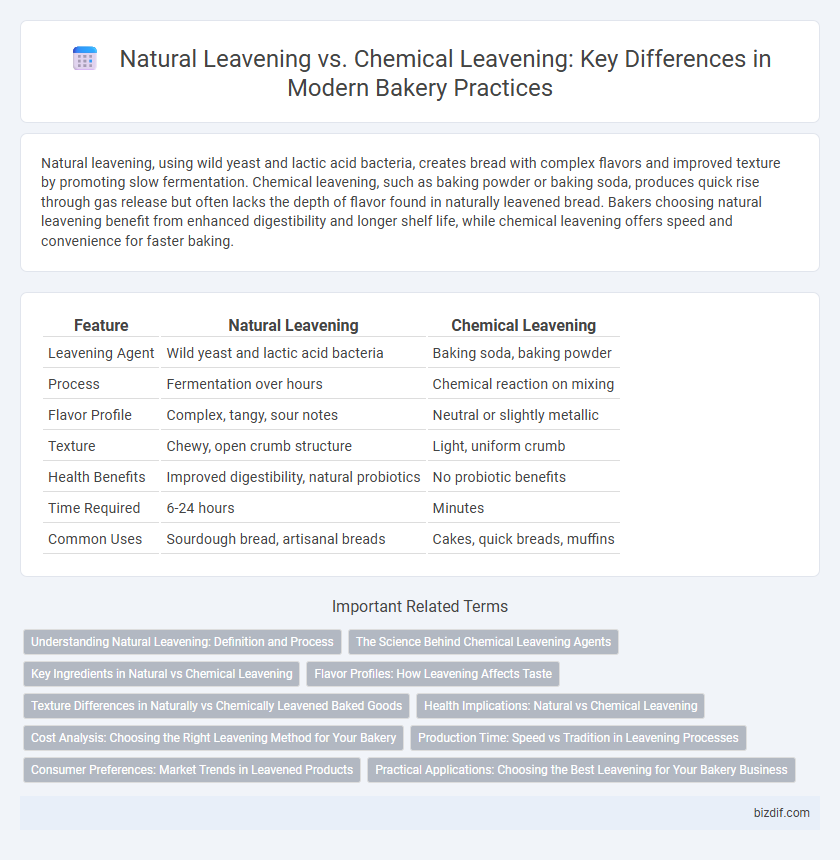Natural leavening, using wild yeast and lactic acid bacteria, creates bread with complex flavors and improved texture by promoting slow fermentation. Chemical leavening, such as baking powder or baking soda, produces quick rise through gas release but often lacks the depth of flavor found in naturally leavened bread. Bakers choosing natural leavening benefit from enhanced digestibility and longer shelf life, while chemical leavening offers speed and convenience for faster baking.
Table of Comparison
| Feature | Natural Leavening | Chemical Leavening |
|---|---|---|
| Leavening Agent | Wild yeast and lactic acid bacteria | Baking soda, baking powder |
| Process | Fermentation over hours | Chemical reaction on mixing |
| Flavor Profile | Complex, tangy, sour notes | Neutral or slightly metallic |
| Texture | Chewy, open crumb structure | Light, uniform crumb |
| Health Benefits | Improved digestibility, natural probiotics | No probiotic benefits |
| Time Required | 6-24 hours | Minutes |
| Common Uses | Sourdough bread, artisanal breads | Cakes, quick breads, muffins |
Understanding Natural Leavening: Definition and Process
Natural leavening relies on wild yeast and lactic acid bacteria present in sourdough starters to ferment dough, producing carbon dioxide and organic acids that enhance flavor and texture. This fermentation process involves the slow cultivation of microorganisms that break down carbohydrates, resulting in a more complex taste profile and improved digestibility. Unlike chemical leavening agents such as baking powder or baking soda, natural leavening requires time and temperature control to develop optimal dough rise and crumb structure.
The Science Behind Chemical Leavening Agents
Chemical leavening agents, such as baking soda (sodium bicarbonate) and baking powder, create carbon dioxide gas through acid-base reactions that cause dough to rise rapidly during baking. These agents rely on precise pH balance and moisture to activate their leavening properties, producing a consistent and predictable rise. Unlike natural leavening, which depends on microbial fermentation, chemical leavening provides faster results and is ideal for quick breads, cakes, and pastries.
Key Ingredients in Natural vs Chemical Leavening
Natural leavening primarily relies on wild yeast and lactic acid bacteria present in sourdough starters, which ferment sugars to produce carbon dioxide and organic acids. Chemical leavening depends on baking soda (sodium bicarbonate) and baking powder, which release carbon dioxide through acid-base reactions when exposed to moisture and heat. These key ingredient differences result in distinct flavor profiles, textures, and fermentation processes in baked goods.
Flavor Profiles: How Leavening Affects Taste
Natural leavening, such as sourdough starters, imparts complex, tangy, and earthy flavors due to fermentation by wild yeast and lactobacilli, enriching the bread's aroma and depth. Chemical leavening, using baking powder or baking soda, produces a neutral taste profile with a lighter texture but lacks the nuanced flavors found in naturally leavened products. The choice between natural and chemical leavening significantly influences the final flavor profile, with natural methods offering more pronounced and layered tastes.
Texture Differences in Naturally vs Chemically Leavened Baked Goods
Natural leavening, such as sourdough starters, creates a more complex and open crumb structure due to the slow fermentation process, which develops gluten and produces carbon dioxide gradually. Chemical leavening agents, like baking powder or baking soda, generate carbon dioxide quickly, resulting in a finer, more uniform crumb with a softer texture. Naturally leavened baked goods tend to have chewier, denser textures with enhanced flavor profiles, while chemically leavened products are lighter and fluffier but lack depth in texture.
Health Implications: Natural vs Chemical Leavening
Natural leavening, using sourdough starters or wild yeast, promotes better digestion and gut health due to the presence of probiotics and reduced phytic acid in bread. Chemical leavening agents such as baking powder or baking soda can cause digestive discomfort and lack beneficial microorganisms found in natural fermentation processes. Choosing natural leavening supports improved nutrient absorption and minimizes exposure to artificial additives, enhancing overall bakery healthfulness.
Cost Analysis: Choosing the Right Leavening Method for Your Bakery
Natural leavening, using sourdough starters, involves higher labor costs and longer fermentation times but yields unique flavors that can justify a premium price point. Chemical leavening agents such as baking powder and baking soda offer faster production times and lower ingredient costs, making them cost-effective for high-volume bakeries. Analyzing overhead expenses, production scale, and target market preferences helps bakeries determine whether the upfront investment in natural leavening or the operational savings of chemical leavening delivers better overall profitability.
Production Time: Speed vs Tradition in Leavening Processes
Natural leavening, relying on wild yeast and bacteria, requires extended fermentation times ranging from 12 to 48 hours, allowing complex flavor development and enhanced texture in bakery products. Chemical leavening agents, such as baking powder and baking soda, produce carbon dioxide rapidly, reducing production time to mere minutes and enabling faster baking cycles. This trade-off between speed and tradition influences bakery operations, as natural leavening embraces slow fermentation for artisanal quality, while chemical leavening prioritizes efficiency and mass production.
Consumer Preferences: Market Trends in Leavened Products
Consumers increasingly favor natural leavening agents such as sourdough and wild yeast due to perceived health benefits and authentic flavor profiles. Market trends show a rising demand for artisanal bread and baked goods made with traditional fermentation processes, reflecting a shift towards clean label and minimally processed products. Chemical leavening agents like baking powder and baking soda remain popular for convenience but face competition from natural alternatives as consumer awareness grows.
Practical Applications: Choosing the Best Leavening for Your Bakery Business
Natural leavening, using sourdough starters or wild yeast, offers a unique flavor profile and improved digestibility, making it ideal for artisan breads and premium products. Chemical leavening agents like baking powder and baking soda provide quick, consistent rise and are best suited for cakes, cookies, and fast-paced production environments. Selecting the best leavening method depends on product type, desired texture, production time, and customer preference for natural ingredients versus convenience.
Natural leavening vs Chemical leavening Infographic

 bizdif.com
bizdif.com